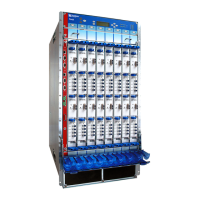• T640 DC Power System Requirements on page 128
• Maintaining the T640 Power Supplies on page 456
• T640 General Electrical Safety Guidelines and Electrical Codes on page 529
T640 DC Power System Requirements
To allow for future growth so that you can operate the T640 router in any hardware
configuration without upgrading the power infrastructure, we recommend that you
provision the following per each input. Doing so enables you to operate the router in any
configuration without upgrading the power infrastructure.
•
68 A @ –48 VDC (nominal) for each power supply input on a two-input 160-A DC
power supply
•
67 A @ –48 VDC (nominal) for input 0 and 67 A @ –48 VDC for input 1 on a three-input
240-A DC power supply
•
50 A @ –48 VDC (nominal) for each power supply input on a four-input 240-A DC
power supply
•
56 A @ –48 VDC (nominal) for each power supply input on a four-input 240-A DC
power supply
If you do not plan to allow for future growth, you can use the information in Table 1 to
calculate the typical power consumption @ –48 VDC and typical thermal output for your
current hardware configuration. Table 72 on page 128 lists the power requirements for
various hardware components when the router is operating under typical voltage
conditions.
Table 72: T640 Component DC Power Requirements
Current Requirement
(Amps @ –48 VDC)Component
16.9 ABase system, not including FPCs and PICs (includes five SIBs, one host subsystem, one SCG,
cooling system, and craft interface), and two DC power supplies
0.8 ASIB: Standard SIB, standard SIB version B, or T640-SIB
3.4 AEnhanced FPC1 and Enhanced II FPC1
7.1 AEnhanced Scaling FPC1
3.4 AFPC2, Enhanced FPC2, and Enhanced II FPC2
7.5 AEnhanced Scaling FPC2
6.8 AFPC3, Enhanced FPC3, and Enhanced II FPC3
9.1 AEnhanced Scaling FPC3
Copyright © 2017, Juniper Networks, Inc.128
T640 Core Router Hardware Guide

